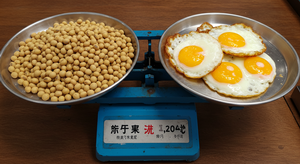The story of soy is long and interesting. Archaeologic al records show that soybeans have been cultivated for over 3,000 years. Cultivation began primarily as a way to improve soil as soy fixates nitrogen in the soil, thus acting as a sort of nitrogen fertilizer. The soy plants were also used as fodder for animals; however, the soybeans were hard to digest and caused issues with the animals. It was found, however, that fermenting the beans solved most of that trouble. Fermentation methods to transform soybeans into early human foods (early miso and soy sauce) began around 200 BCE. The use of soy sauce migrated to Japan by around the 7th century, while the creation of nattō, a sticky soy bean ferment, did not appear until the 10th century. Tempeh was developed in Indonesia around the 17th century. al records show that soybeans have been cultivated for over 3,000 years. Cultivation began primarily as a way to improve soil as soy fixates nitrogen in the soil, thus acting as a sort of nitrogen fertilizer. The soy plants were also used as fodder for animals; however, the soybeans were hard to digest and caused issues with the animals. It was found, however, that fermenting the beans solved most of that trouble. Fermentation methods to transform soybeans into early human foods (early miso and soy sauce) began around 200 BCE. The use of soy sauce migrated to Japan by around the 7th century, while the creation of nattō, a sticky soy bean ferment, did not appear until the 10th century. Tempeh was developed in Indonesia around the 17th century. |
While fermentation was one way to make soybeans  more digestible, another process was developed during the Han Dynasty (approximately 160 BCE) that involved first soaking the beans overnight, then grinding the beans and boiling them. The resulting slurry is then filtered to separate the soy milk from the fiber. A coagulant is added to the hot soy milk (lemon juice, magnesium chloride, or calcium sulfate), causing the soy proteins to curdle. The protein curdles are gathered together into blocks, which we know as tofu. So tofu has been used as a staple protein food for over 2200 years. more digestible, another process was developed during the Han Dynasty (approximately 160 BCE) that involved first soaking the beans overnight, then grinding the beans and boiling them. The resulting slurry is then filtered to separate the soy milk from the fiber. A coagulant is added to the hot soy milk (lemon juice, magnesium chloride, or calcium sulfate), causing the soy proteins to curdle. The protein curdles are gathered together into blocks, which we know as tofu. So tofu has been used as a staple protein food for over 2200 years.
While some fermented soy products made it over to Europe through Portuguese and Dutch traders in the 16th to 18th centuries, soy did not start to be raised in the US until the 19th century, primarily as fodder. It was not until the 1920s that soy really got going, promoted as a source for oil in American cooking. By 1950, soy oil overtook butter and lard as the most common cooking oils in the US. Now we have all sorts of soy-based products filling our grocer’s shelves. Nonetheless, globally, over 75% of the soy grown is used as feed for animals. This reality has become a bit of an ecological concern as much deforestation takes place to make room for soy crops, particularly in South America. 18th centuries, soy did not start to be raised in the US until the 19th century, primarily as fodder. It was not until the 1920s that soy really got going, promoted as a source for oil in American cooking. By 1950, soy oil overtook butter and lard as the most common cooking oils in the US. Now we have all sorts of soy-based products filling our grocer’s shelves. Nonetheless, globally, over 75% of the soy grown is used as feed for animals. This reality has become a bit of an ecological concern as much deforestation takes place to make room for soy crops, particularly in South America.
I first encountered soy-based food products while I was attending UC Davis. Living on a student’s budget meant eating very cheaply. One such move was to introduce textured vegetable protein into my cooking. Generally, this was not a very tasty choice. A little later, when I looked up what was in this stuff, I discovered that it was really just processed soybean. At that time, what I could find on soy as a food was some studies done in the 40’s and 50’s on baby pigs. Basically, they found that feeding baby pigs soybeans or soy meal that the babies died of malnutrition. Farmers had known about this issue for a long time, but now actual academic researchers had “discovered” the same thing. After a few years of research, they discovered the problem was that soy contains several anti-nutrients. Most notably was a trypsin inhibitor. Trypsin is a primary enzyme your pancreas releases to enable you to digest proteins. The inhibitor does just what the name says – it stops that enzyme from working, which means that you cannot digest your protein foods. No protein, you die. Fortunately, the researchers “discovered” that cooking the soybeans first inactivated this anti-nutrient. I say “discovered” because the Chinese discovered the same thing over 2000 years ago when they came up with the recipe for making tofu. attending UC Davis. Living on a student’s budget meant eating very cheaply. One such move was to introduce textured vegetable protein into my cooking. Generally, this was not a very tasty choice. A little later, when I looked up what was in this stuff, I discovered that it was really just processed soybean. At that time, what I could find on soy as a food was some studies done in the 40’s and 50’s on baby pigs. Basically, they found that feeding baby pigs soybeans or soy meal that the babies died of malnutrition. Farmers had known about this issue for a long time, but now actual academic researchers had “discovered” the same thing. After a few years of research, they discovered the problem was that soy contains several anti-nutrients. Most notably was a trypsin inhibitor. Trypsin is a primary enzyme your pancreas releases to enable you to digest proteins. The inhibitor does just what the name says – it stops that enzyme from working, which means that you cannot digest your protein foods. No protein, you die. Fortunately, the researchers “discovered” that cooking the soybeans first inactivated this anti-nutrient. I say “discovered” because the Chinese discovered the same thing over 2000 years ago when they came up with the recipe for making tofu.
I did not know how TVP was made, but this info made me wary of soy products. A few years later, information came o ut about phytoestrogens – plant-based estrogen compounds. As a guy, this seemed like a bad idea for me to be taking. Back then, the relative weakness of soy estrogen compounds was not known. In fact, doctors were recommending soy as a treatment for menopause as a natural substitute for estrogen hormone replacement therapy. Back then, we did not understand that what is really needed for menopause is progesterone, not estrogen. At this point, studies seem to say that soy does not reduce testosterone in men and is generally healthy for women, though caution is still advised for women that have estrogen-sensitive breast cancers. ut about phytoestrogens – plant-based estrogen compounds. As a guy, this seemed like a bad idea for me to be taking. Back then, the relative weakness of soy estrogen compounds was not known. In fact, doctors were recommending soy as a treatment for menopause as a natural substitute for estrogen hormone replacement therapy. Back then, we did not understand that what is really needed for menopause is progesterone, not estrogen. At this point, studies seem to say that soy does not reduce testosterone in men and is generally healthy for women, though caution is still advised for women that have estrogen-sensitive breast cancers.
Are there other negatives for soy? Yes. Soy is one of the top allergenic reactive foods, so caution is needed. Soy c ontains certain complex sugars that can cause digestive distress for some people. Raw soybeans are filled with anti-nutrients like the trypsin inhibitors and phytates, so never eat edamame. While whole soy foods (like tofu, tempeh, and miso) are generally safe, TVP, soy protein isolate, soy oil, and many soy-based meat replacements are really ultra-processed foods that should be avoided. There is a lot of controversy around the genetic modification of soy as well as all the pesticides and fungicides used on the soy crops. And then there are the ecological considerations of deforestation. ontains certain complex sugars that can cause digestive distress for some people. Raw soybeans are filled with anti-nutrients like the trypsin inhibitors and phytates, so never eat edamame. While whole soy foods (like tofu, tempeh, and miso) are generally safe, TVP, soy protein isolate, soy oil, and many soy-based meat replacements are really ultra-processed foods that should be avoided. There is a lot of controversy around the genetic modification of soy as well as all the pesticides and fungicides used on the soy crops. And then there are the ecological considerations of deforestation.
After considering the various soy negatives, the ques tion now comes down to ‘is soy good for us to eat?’ Soy is the highest protein plant food, and quite usable for that purpose once it has been cooked and properly prepared. It is a complete protein, meaning that it has all the essential amino acids, unlike various grains. The amino acid ratios are not perfect, not as good as egg white, the gold standard for digestible and usable protein. Soy is a little deficient in the sulfur-containing amino acids methionine and cysteine. This can be counterbalanced by eating your soy meal with something that contains extra methionine, like rice, wheat, corn, or oats. This is a technique I first learned while in chiropractic school from a book called Diet for a Small Planet. Back then I was a vegetarian. I followed this protocol for a couple of years until I got so sick with blood sugar imbalances that I had to quit and go the opposite path with a keto diet to regain my health. My system is very sensitive to carbohydrates and I develop blood sugar imbalances super easily. Even a few days of carbs and my health crashes. Most people are not this way, but some are. Believe me, if I could I would eat sourdough bread every day, but the price is too high. tion now comes down to ‘is soy good for us to eat?’ Soy is the highest protein plant food, and quite usable for that purpose once it has been cooked and properly prepared. It is a complete protein, meaning that it has all the essential amino acids, unlike various grains. The amino acid ratios are not perfect, not as good as egg white, the gold standard for digestible and usable protein. Soy is a little deficient in the sulfur-containing amino acids methionine and cysteine. This can be counterbalanced by eating your soy meal with something that contains extra methionine, like rice, wheat, corn, or oats. This is a technique I first learned while in chiropractic school from a book called Diet for a Small Planet. Back then I was a vegetarian. I followed this protocol for a couple of years until I got so sick with blood sugar imbalances that I had to quit and go the opposite path with a keto diet to regain my health. My system is very sensitive to carbohydrates and I develop blood sugar imbalances super easily. Even a few days of carbs and my health crashes. Most people are not this way, but some are. Believe me, if I could I would eat sourdough bread every day, but the price is too high.
Is there other good stuff to recommend, including soy in our diet? It is a good source of protein. While tofu is about 8% protein, Tempeh (fermented soy) is an excellent 19% protein. Steak comes in at around 28% protein. Evidence suggests that eating soy foods does reduce hot flashes and improves bone health. There is also evidence that soy mildly reduces LDL cholesterol and triglycerides, which suggests that it might reduce heart disease. The jury is still out about the whole cholesterol – heart disease link. But the bottom line is that soy foods look like they can be used successfully for most people as a good protein source. Individual sensitivities may alter that perspective. Try it and see how well you do with it. If you have digestive issues with soy or if it messes with your blood sugar, then leave it out of your diet. protein, Tempeh (fermented soy) is an excellent 19% protein. Steak comes in at around 28% protein. Evidence suggests that eating soy foods does reduce hot flashes and improves bone health. There is also evidence that soy mildly reduces LDL cholesterol and triglycerides, which suggests that it might reduce heart disease. The jury is still out about the whole cholesterol – heart disease link. But the bottom line is that soy foods look like they can be used successfully for most people as a good protein source. Individual sensitivities may alter that perspective. Try it and see how well you do with it. If you have digestive issues with soy or if it messes with your blood sugar, then leave it out of your diet.
Basically, the concerns and fears I had back in the 7 0s and 80s don’t seem to matter much now. I would still look for organic soy products that have not been genetically modified. There is still too much that is not known about that whole arena. It can make a useful addition to your diet, particularly if you balance it with a bit of rice or corn. Hormonally, most people should do fine with soy, but I do have some patients that are very sensitive to soy on that level. It is a common allergen, so pay attention. Otherwise, check it out and see how you do. 0s and 80s don’t seem to matter much now. I would still look for organic soy products that have not been genetically modified. There is still too much that is not known about that whole arena. It can make a useful addition to your diet, particularly if you balance it with a bit of rice or corn. Hormonally, most people should do fine with soy, but I do have some patients that are very sensitive to soy on that level. It is a common allergen, so pay attention. Otherwise, check it out and see how you do.
Take care,
David
We were doing Ellen’s morning exercises beside the bed when I happened to look out the window at the orange tree in my back yard. There was a red blossom in the middle of it. Oran ge trees should not have red blossoms. After finishing the exercises I went out to see what this was all about. When I got to the tree I found that a volunteer crepe myrtle had shot up into the orange tree and was making a show of itself. I picked the showy blossom as a present for Ellen. ge trees should not have red blossoms. After finishing the exercises I went out to see what this was all about. When I got to the tree I found that a volunteer crepe myrtle had shot up into the orange tree and was making a show of itself. I picked the showy blossom as a present for Ellen.
Comparing folks that don’t drink much water per day –  average of 1.3 liters to folks that average over 4 liters per day showed that when both groups were put in stressful situations, the low water group had 55% more cortisol (stress hormone) release. average of 1.3 liters to folks that average over 4 liters per day showed that when both groups were put in stressful situations, the low water group had 55% more cortisol (stress hormone) release.
More
___________________________
“Learn and let go. Our life stories are to learn from and then let go, not identify with. To hold on is to stop our growth. This is the real reason for forgiveness.“
~David DeLapp
_____________________________________
Electrical rheumatoid arthritis treatment
The FDA has just approved an implantable electrical
 stimulator for the vagus nerve designed to treat rheumatoid arthritis. This is totally new. No drugs involved. Studies have shown significant improvement with RA patients by stimulating their own relaxation nerves. This turns down the immune system overactivation that kicks autoimmune disease into action. There are many ways to stimulate the vagus nerve. stimulator for the vagus nerve designed to treat rheumatoid arthritis. This is totally new. No drugs involved. Studies have shown significant improvement with RA patients by stimulating their own relaxation nerves. This turns down the immune system overactivation that kicks autoimmune disease into action. There are many ways to stimulate the vagus nerve.
More
____________________________
“Chance favors the prepared mind. Life is filled with random opportunity. The more you know, seek, and engage, the more you can create what you want.“
~David DeLapp
________________________________________
Smoking is good for colitis?
This is a strange observation that doctors have seen fo r a long time – smoking calms down colitis, but makes Crohn’s disease worse. New research has figured out why. A metabolite of smoking allowed different bacteria to thrive int the gut which activated certain immune cells to fight off some bad guys that were causing the inflammation in the colitis. r a long time – smoking calms down colitis, but makes Crohn’s disease worse. New research has figured out why. A metabolite of smoking allowed different bacteria to thrive int the gut which activated certain immune cells to fight off some bad guys that were causing the inflammation in the colitis.
More
________________________
“Humility frees me to create what serves me best. When we are trapped in ego competition with others our creative energy is sucked into these games.“
~David DeLapp
|
|
|

